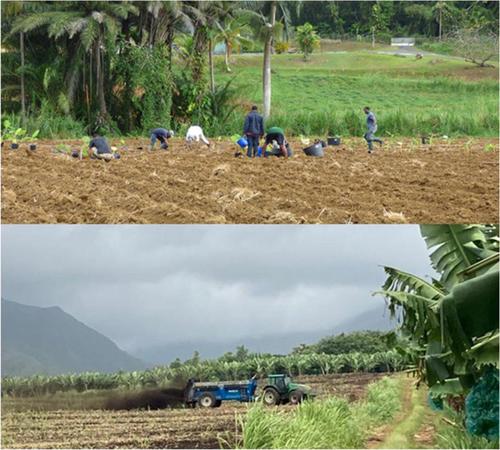Agronomy for Sustainable Development ( IF 6.4 ) Pub Date : 2022-06-13 , DOI: 10.1007/s13593-022-00782-8 Audrey Fanchone , Gisèle Alexandre , Nathalie Hostiou

|
Crop–livestock integration exploits the synergies between cropping and livestock systems, mainly by using animal excreta as an organic crop fertilizer or using crop products as animal feed. From an environmental and economic point of view, crop–livestock integration is thought to increase system autonomy and resilience. However, little research has addressed its social impact and particularly the relationship between crop-livestock integration and work organization although, like most agroecological practices, crop-livestock integration was considered time- and labor-intensive. Here we used quantitative indicators based on the “Qualification and Evaluation of Work” method coupled with qualitative interviews with farmers to understand how implementation of crop–livestock integration practices is affected by work characteristics (perception, organization, duration, and arduousness). This framework was implemented on 14 farms selected from a typology of mixed crop–livestock systems in Guadeloupe (French West Indies), where high labor costs heighten the tension between work organization and agroecological practices. Our results show that three patterns of crop–livestock integration shaped work organization: family farms with strong crop–livestock integration (Pattern 1, n=6 farms), farms with moderate crop–livestock integration (Pattern 2, n=5 farms), and intensive productivity-driven farms (Pattern 3, n=3 farms). We also show for the first time that farmer perceptions of work, especially with animals, influences level of implementation of crop–livestock integration practices. In Pattern 1, work with livestock is done by the farmers themselves or by skilled and trusted persons from their inner circle. In Pattern 3, livestock was considered a source of on-farm income, and work with livestock, including crop–livestock integration practices, is readily delegated to employees or volunteers. Whatever the pattern, the time burden of collecting crop-products and excreta was cited as a primary barrier to further implementation. Actionable opportunities for further implementation of these patterns of crop–livestock integration practices are discussed.
中文翻译:

工作组织是农牧一体化实践的障碍:瓜德罗普岛的案例研究
农牧一体化利用种植和畜牧系统之间的协同作用,主要是通过使用动物排泄物作为有机作物肥料或使用农作物作为动物饲料。从环境和经济的角度来看,农牧结合被认为可以提高系统的自主性和弹性。然而,很少有研究涉及其社会影响,特别是作物-牲畜整合与工作组织之间的关系,尽管与大多数农业生态实践一样,作物-牲畜整合被认为是时间和劳动密集型的。在这里,我们使用基于“工作资格和评估”方法的定量指标与农民的定性访谈相结合,以了解农牧一体化实践的实施如何受到工作特征(感知、组织、持续时间和艰巨性)。该框架在瓜德罗普岛(法属西印度群岛)从农牧混合系统类型中选出的 14 个农场实施,那里的高劳动力成本加剧了工作组织和农业生态实践之间的紧张关系。我们的研究结果表明,三种农牧融合模式塑造了工作组织:农牧融合强的家庭农场(模式 1,n=6 农场),农牧融合适度的农场(模式 2,n=5 农场),和集约型生产力驱动的农场(模式 3,n=3 个农场)。我们还首次表明,农民对工作的看法,尤其是对动物的看法,会影响农牧一体化实践的实施水平。在模式 1 中,饲养牲畜的工作由农民自己或他们核心圈子中熟练和值得信赖的人完成。在模式 3 中,牲畜被认为是农场收入的来源,与牲畜相关的工作,包括作物与牲畜的整合实践,很容易被委派给员工或志愿者。无论采用何种模式,收集作物产品和排泄物的时间负担都被认为是进一步实施的主要障碍。讨论了进一步实施这些农牧一体化实践模式的可行机会。收集作物产品和排泄物的时间负担被认为是进一步实施的主要障碍。讨论了进一步实施这些农牧一体化实践模式的可行机会。收集作物产品和排泄物的时间负担被认为是进一步实施的主要障碍。讨论了进一步实施这些农牧一体化实践模式的可行机会。











































 京公网安备 11010802027423号
京公网安备 11010802027423号